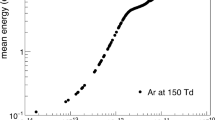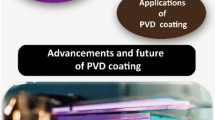Abstract
A careful substrate preparation and the physical properties of the coating particles are decisive for the quality and envisaged properties of the deposited layer. Temperature, size, rate and velocity represent the classical quantities, which can be measured in situ using various diagnostics. Nonetheless, another quality-determining parameter is the degree of oxidation which could not be measured in situ (up to now) by established diagnostics and must therefore be qualitatively derived from the above-mentioned quantities or subsequently be measured by means of destructive methods. Within this work, a diagnostic approach to determine in-flight particle oxidation has been outlined and tested. The presented measurement method detects the entire particle plume from different directions using a 2D two-color pyrometry and allows for the calculation of spatially resolved 3D temperature and intensity distributions based on a tomographic evaluation method. By additionally using measurements of the particle velocities and particle sizes, the surface emissivity of the particles along the spraying direction can be calculated, which in turn allows quantitative conclusions on the degree of particle oxidation. Investigations on the wire arc spraying process have shown that particle oxidation degrees could be determined and tend to correlate well with oxide contents in finished coatings.









Similar content being viewed by others
Abbreviations
- λ :
-
Wavelength
- \(T\) :
-
Particle temperature
- ε(λ, T):
-
Emissivity
- \(M_{{\lambda {\text{s}}}} \left( {\lambda , T} \right)\) :
-
Spectral exitance, a function of wavelength and particle temperature
- \(Q\left( T \right)\) :
-
Quotient for temperature calculation
- \(K = \frac{hc}{{k_{T} }}\) :
-
Constant (Planck’s constant times speed of light divided by Boltzmann constant)
- \(I_{{i,{\text{tot}}}}\) :
-
(Total) intensity registered by the ith camera
- \(i\) :
-
Integer value describing the camera number (1 or 2)
- \(p\left( {\phi , a} \right)\) :
-
Projection value
- \(f\left( {x,y} \right)\) :
-
Spatial distribution function
- \(L_{\phi ,a}\) :
-
Integration straight for the radon transformation
- \(a\) :
-
Angle number, i.e., the number of projections
- \(\phi\) :
-
Projection angle
- \(\Delta \phi\) :
-
Angle step at which tomographic projections are acquired
- \(A_{ \bot , k}\) :
-
Luminous surface of a kth particle
- \(t_{C, k}\) :
-
Dwell time in an observation cross section as defined in Ref 1
- \(N\) :
-
Amount of particles flying through an observation cross section
- \(B_{i}\) :
-
Calibration factor
- \(\lambda_{s,e}\) :
-
Initial and final wavelength of the integration of \(I_{{i,{\text{tot}}}}\)
- \(q_{\text{e}}\) :
-
Quantum efficiency of the detector
- \(f_{i}\) :
-
Transmission function of a spectral filter
- \(v_{\text{W}}\) :
-
Wire feed rate
- \(r_{\text{W}}\) :
-
Wire radius
- \(r_{\text{P}}\) :
-
Particle radius
- \(t_{ \exp }\) :
-
Exposure time of the detector
- \(l_{C}\) :
-
Edge length of a pixel in the image plane
- \(v_{\text{lamp}}\) :
-
Velocity of the calibration lamp movement across the detector
- \(C_{\text{oxide}}\) :
-
Oxide content of particles in flight
- \(v_{P, z}\) :
-
Particle velocity along the spraying direction, defined as z-axis
References
S. Kirner, Tomographic Two-Color-Pyrometry of the Wire Arc Spray Process regarding Particle Temperature and in-flight Particle Oxidation, Ph.D. Thesis, Faculty of Plasma Technology and Basics of Electrical Engineering, Bundeswehr University Munich, Neubiberg, 2018
M.-M. Matz and M. Aumiller, Practical Comparison of Cylindrical Nozzle and De Laval Nozzle for Wire Arc Spraying, J. Therm. Spray Technol., 2014, 23(8), p 1470-1477
E. Hämäläinen et al., Imaging Diagnostics in Thermal Spraying-SprayWatch System, Thermal Spray: Surface Engineering via Applied Research, C.C. Berndt, Ed., Montréal, ASM International, 2000
J. Vattulainen et al., Novel Method for In-Flight Particle Temperature and Velocity Measurements in Plasma Spraying Using a Single CCD Camera, J. Therm. Spray Technol., 2001, 10(1), p 94-104
G. Mauer, R. Vaßen, and D. Stöver, Comparison and Applications of DPV-2000 and Accuraspray-g3 Diagnostic Systems, J. Therm. Spray Technol., 2007, 16(3), p 414-424
C. Moreau et al., Diagnostics for Advanced Materials Processing by Plasma Spraying, Pure Appl. Chem., 2005, 77(2), p 443-462
G.E. Elsinga et al., Tomographic 3D-PIV and Applications, Particle Image Velocimetry Top. Appl. Phys., 2007, 112, p 103-125
S. Kirner, G. Forster, and J. Schein, Tomographic Particle Localization and Velocity Measurement, J. Therm. Spray Technol., 2015, 24(1-2), p 38-45
J.R. Fincke, W.D. Swank, and C.L. Jeffery, Simultaneous Measurement of Particle Size, Velocity and Temperature in Thermal Plasmas, IEEE Trans. Plasma Sci., 1990, 18(6), p 948-957
J. Hlína and J. Šonský, Time-Resolved Tomographic Measurements of Temperatures in a Thermal Plasma Jet, J. Phys. D Appl. Phys., 2010, 43(5), p 55202
J. Schein et al., Tomographic Investigation of Plasma Jets Produced by Multielectrode Plasma Torches, J. Therm. Spray Technol., 2008, 17(3), p 338-343
J.R. Fincke, D.C. Haggard, and W.D. Swank, Particle Temperature Measurement in the Thermal Spray Process, J. Therm. Spray Technol., 2001, 10(2), p 255-266
T. Streibl, T. Duda and K. Landes, Diagnostics of Thermal Spray Processes By In-Flight Measurement of Particle Size and Shape with Innovative Particle-Shape-Imaging (PSI) Technique, in Proc. SPIE 4308, High-Speed Imaging and Sequence Analysis III, 2001
F. Durst, A. Melling, and J.H. Whitelaw, Principles and Practice of Laser-Doppler Anemometry, Academic Press, New York, 1976
A.P. Newbery and P.S. Grant, Oxidation During Electric Arc Spray Forming of Steel, J. Mater. Process. Technol., 2006, 178(1), p 259-269
R.A. Neiser, M.F. Smith, and R.C. Dykhuizen, Oxidation in Wire HVOF-Sprayed Steel, J. Therm. Spray Technol., 1998, 7(4), p 537-545
K. Voleník et al., Properties of Alloy Steel Coatings Oxidized During Plasma Spraying, Mater. Sci. Eng., A, 1997, 234-236, p 493-496
S. Deshpande, S. Sampath, and H. Zhang, Mechanisms of Oxidation and Its Role in Microstructural Evolution of Metallic Thermal Spray Coatings—Case Study for Ni-Al, Surf. Coat. Technol., 2006, 200(18-19), p 5395-5406
G. Espie et al., In-Flight Oxidation of Iron Particles Sprayed Using Gas and Water Stabilized Plasma Torch, Surf. Coat. Technol., 2005, 195(1), p 17-28
J.R. Davis, Handbook of Thermal Spray Technology, ASM International, Cleveland, 2004
X. Wang et al., Effect of Nozzle Configuration, Gas Pressure, Gas Type on Coating Properties in Wire Arc Spray, J. Therm. Spray Technol., 1999, 8(4), p 565-575
S. Hoile et al., Oxide Formation in the Sprayform Tool Process, Mater. Sci. Eng., A, 2004, 383(1), p 50-57
L. Michalski et al., Temperature Measurement, 2nd ed., Wiley, Hoboken, 2004
Z. Zhou et al., 3-D Reconstruction of Flame Temperature Distribution Using Tomographic and Two-Color Pyrometric Techniques, IEEE Trans. Instrum. Meas., 2015, 64(11), p 3075-3084
T.M. Buzug, Computed Tomography: From Photon Statistics to Modern Cone-Beam CT, Springer, Berlin, 2008
A. Fridman, Plasma Chemistry, Cambridge University Press, Cambridge, 2008
A. Fridman and L. Kennedy, Plasma Physics and Engineering, Taylor & Francis, Milton Park, 2004
M. Szulc et al., A Method to Estimate the Optical Thickness of an Opaque Stream of Particles Based on Particle Rate, Size and Velocity Measurements as a Necessity to Enable Tomographic Analysis, J. Therm. Spray Technol., 2019, 28, p 1627-1635
J. Radon, Über die Bestimmung von Funktionen durch ihre Integralwerte längs gewisser Mannigfaltigkeiten, Berichte über die Verhandlungen der Königlich Sächsischen Gesellschaft der Wissenschaften zu Leipzig, Mathematisch-Physische Klasse, 1917, 69, p 262-277
S. Kaczmarz, Angenäherte Auflösung von Systemen linearer Gleichungen, Bulletin International de l’Academie Polonaise des Sciences et des Lettres, 1937, 35, p 355-357
G. Jandin et al., Correlations Between Operating Conditions, Microstructure and Mechanical Properties of Twin Wire Arc Sprayed Steel Coatings, Mater. Sci. Eng., A, 2003, 349(1), p 298-305
M.P. Planche, H. Liao, and C. Coddet, Relationships Between In-Flight Particle Characteristics and Coating Microstructure with a Twin Wire Arc Spray Process and Different Working Conditions, Surf. Coat. Technol., 2004, 182(2-3), p 215-226
B. Böhme, Neue Präparationswege für intermetallische Verbindungen, Logos, 2010
H. Watanabe et al., Phase (Liquid/Solid) Dependence of the Normal Spectral Emissivity for Iron, Cobalt, Nickel at Melting Points, Int. J. Thermophys., 2003, 24(2), p 473-488
ewm GmbH, Schweißzusatzwerkstoffe: Handbuch, 2016. Available: https://www.ewm-group.com/downloads/259184/WM_0924_00.PDF
Datasheet S235JR, Salzgitter Flachstahl, 2011. Available: https://www.salzgitter-flachstahl.de/fileadmin/mediadb/szfg/informationsmaterial/produktinformationen/warmgewalzte_produkte/deu/S235JR.pdf
N. Birks, G. Meier, and F. Pettit, Introduction to the High Temperature Oxidation of Metals, Cambridge University Press, Cambridge, 2006
D.J. Young, High Temperature Oxidation and Corrosion of Metals, Elsevier, Amsterdam, 2008
A. Khanna, Introduction to High Temperature Oxidation and Corrosion, ASM International, Milton Park, 2002
A. Ivarson et al., The Oxidation Dynamics of Laser Cutting of Mild Steel and the Generation of Striations on the Cut Edge, J. Mater. Process. Technol., 1994, 40(3-4), p 359-374
H. Schöpp et al., Temperature and Emissivity Determination of Liquid Steel S235, J. Phys. D Appl. Phys., 2012, 45(23), p 235203
M. Muller et al., Temperature Measurement of Laser Heated Metals in Highly Oxidizing Environment Using 2D Single-Band and Spectral Pyrometry, J. Laser Appl., 2012, 24(2), p 22006
H. Kobatake, H. Khosroabadi, and H. Fukuyama, Normal Spectral Emissivity Measurement of Liquid Iron and Nickel Using Electromagnetic Levitation in Direct Current Magnetic Field, Metall. Mater. Trans. A, 2012, 43(7), p 2466-2472
M. Kelkar and J. Heberlein, Wire-Arc Spray Modeling, Plasma Chem. Plasma Proc., 2002, 22(1), p 1-25
B.J. Keene, Review of Data for the Surface Tension of Pure Metals, Int. Mater. Rev., 2013, 38(4), p 157-192
A.P. Newbery, P.S. Grant, and R.A. Neiser, The Velocity and Temperature of Steel Droplets During Electric arc Spraying, Surf. Coat. Technol., 2005, 195(1), p 91-101
D.L. Hale, W.D. Swank, and D.C. Haggard, In-Flight Particle Measurements of Twin Wire Electric Arc Sprayed Aluminum, J. Therm. Spray Technol., 1998, 7(1), p 58-63
W. Tillmann, E. Vogli, and M. Abdulgader, Asymmetric Melting Behavior in Twin Wire Arc Spraying with Cored Wires, J. Therm. Spray Technol., 2008, 17(5-6), p 974-982
J. Prehm, Modellierung thermisch-physikalischer Vorgänge beim Thermischen Spritzen, Ph.D. Thesis, Fakultät für Maschinenbau, Gottfried Wilhelm Leibniz Universität Hannover, Hannover, 2014
Z. Zhengji, LDA Application Methods: Laser Doppler Anemometry for Fluid Dynamics, Springer, Berlin, 2010
A. Pourmousa et al., Particle Size Distribution in a Wire-Arc Spraying System, J. Therm. Spray Technol., 2005, 14(4), p 502-510
Author information
Authors and Affiliations
Corresponding author
Additional information
Publisher's Note
Springer Nature remains neutral with regard to jurisdictional claims in published maps and institutional affiliations.
Rights and permissions
About this article
Cite this article
Szulc, M., Kirner, S., Forster, G. et al. A Novel Approach to Determine In-Flight Particle Oxidation for Thermal Spraying Processes. J Therm Spray Tech 29, 932–946 (2020). https://doi.org/10.1007/s11666-020-01055-0
Received:
Revised:
Published:
Issue Date:
DOI: https://doi.org/10.1007/s11666-020-01055-0




